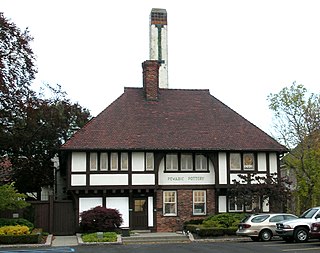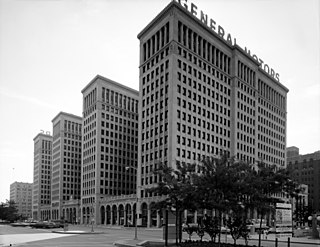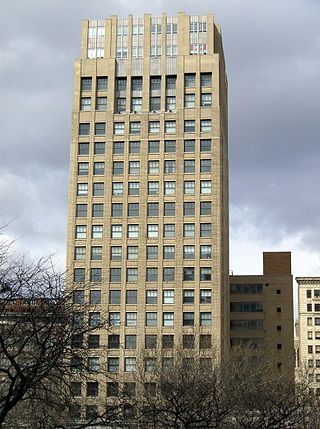
Pewabic Pottery is a ceramic studio and school in Detroit, Michigan. Founded in 1903, the studio is known for its iridescent glazes, some of which grace notable buildings such as the Shedd Aquarium and Basilica of the National Shrine of the Immaculate Conception. The pottery continues in operation today, and was designated a National Historic Landmark in 1991.

Cadillac Place, formerly the General Motors Building, is a landmark high-rise office complex located at 3044 West Grand Boulevard in the New Center area of Detroit, Michigan. It was renamed for the French founder of Detroit, Antoine Laumet de La Mothe, sieur de Cadillac. It is a National Historic Landmark in Michigan, listed in 1985.

The Guardian Building is a landmark skyscraper in the United States, located at 500 Griswold Street in Downtown Detroit, Michigan, within the Financial District. The Guardian is a class-A office building owned by Wayne County, Michigan and serves as its headquarters. Built in 1928 and finished in 1929, the building was originally called the Union Trust Building and is a bold example of Art Deco architecture, including art moderne designs. At the top of the Guardian Building's spire is a large U.S. flag, complementing the four smaller flags atop nearby 150 West Jefferson. The building has undergone recent award-winning renovations. It was designated a National Historic Landmark on June 29, 1989, and the associated Detroit Financial District is on the National Register of Historic Places. The Guardian building includes retail and a tourist gift shop.

The Fox Theatre is a performing arts center located at 2211 Woodward Avenue in Downtown Detroit, Michigan, near the Grand Circus Park Historic District. Opened in 1928 as a flagship movie palace in the Fox Theatres chain, it was at over 5,000 seats the largest theater in the city. Designed by theater architect C. Howard Crane, it was listed on the National Register of Historic Places in 1985.

The Scarab Club is an artists' club, gallery, and studio in the Cultural Center Historic District of Detroit, Michigan, located at 217 Farnsworth Street, near the Detroit Institute of Arts and the Detroit Science Center. It was designated a Michigan State Historic Site in 1974 and listed on the National Register of Historic Places in 1979.

The Gem Theatre is a performing arts theater located in Detroit, Michigan. Built in 1927 in the Spanish Revival style, it houses a two level theater with traditional row and aisle seating along with stage-level seating at cabaret tables. The Gem Theatre was listed on the National Register of Historic Places in 1985. It shares a lobby with the cabaret-style Century Theatre, built in 1903.

Grand Park Centre, also known as the Michigan Mutual Building, is a high-rise office building in downtown Detroit, Michigan, located at 28 West Adams Avenue, at the corner of Adams Avenue West and Woodward Avenue, standing across from Grand Circus Park in the Foxtown neighbourhood. Nearby buildings and attractions are Grand Circus Park, Comerica Park, Ford Field, the Dime Building, and Campus Martius Park. The building is a part of the Michigan Mutual Liability Company Complex, with the Michigan Mutual Liability Annex. The building is located in the Foxtown neighborhood of Detroit.

The Albert, formerly the Griswold Building, is a former office building named after architect Albert Kahn, located at 1214 Griswold Street in Downtown Detroit, Michigan. It was listed on the National Register of Historic Places in 1980 and is part of the Capitol Park Historic District. In 2014, it was renovated into apartments.

The Music Hall Center for Performing Arts is a 1,731-seat theatre located in the city's theatre district at 350 Madison Street in Downtown Detroit, Michigan. It was built in 1928 as the Wilson Theatre, designated a Michigan State Historic Site in 1976, and was listed on the National Register of Historic Places in 1977.

Mary Chase Perry Stratton was an American ceramic artist. She was a co-founder, along with Horace James Caulkins, of Pewabic Pottery, a form of ceramic art used to make architectural tiles.

The Wayne State University historic district consists of three buildings on 4735-4841 Cass Avenue in Midtown Detroit, Michigan: the Mackenzie House, Hilberry Theatre, and Old Main, all on the campus of Wayne State University. The buildings were designated a Michigan State Historic Site in 1957 and listed on the National Register of Historic Places in 1978.

The Park Avenue House is a high rise residential building located at 2305 Park Avenue in the Park Avenue Historic District in Downtown Detroit, Michigan. It was listed on the National Register of Historic Places in 1996. It should not be confused with the nearby Park Avenue Hotel, which was demolished in 2015.

The Eddystone Building is a former hotel located in Midtown Detroit, Michigan, at 100-118 Sproat Street. It was listed on the National Register of Historic Places in 2006.

The Harmonie Club is a club located at 267 East Grand River Avenue in Downtown Detroit, Michigan. It was designated a Michigan State Historic Site in 1975 and listed on the National Register of Historic Places in 1980.

The Frederick Stearns Building is a manufacturing plant located at 6533 East Jefferson Avenue in Detroit, Michigan. The building was listed on the National Register of Historic Places in 1980 and designated a Michigan State Historic Site in 1981. It has been converted to condominiums.

The Kingston Arms Apartments is an apartment building located at 296 East Grand Boulevard in Detroit, Michigan, in the East Grand Boulevard Historic District. It was listed on the National Register of Historic Places in 1999. The Kingston Arms, built in 1924, is a representative example of the rise of middle-class apartment buildings in pre-Depression era Detroit.

The Most Holy Redeemer Church is located at 1721 Junction Street in Southwest Detroit, Michigan, within the West Vernor–Junction Historic District. The church was once estimated as the largest Roman Catholic parish in North America. West Vernor–Junction Historic District is adjacent to Mexicantown and contains a growing Mexican community and resurgent neighborhood.

The Detroit Financial District is a United States historic district in downtown Detroit, Michigan. The district was listed on the U.S. National Register of Historic Places on December 14, 2009, and was announced as the featured listing in the National Park Service's weekly list of December 24, 2009.

The Park Avenue Hotel was a hotel in the Cass Corridor of Detroit, Michigan. It was listed on the National Register of Historic Places in 2006. It was also known as Salvation Army Harbor Light Center and is not to be confused with Park Avenue House, also once known as Park Avenue Hotel. The building was imploded on July 11, 2015.

The William B. and Mary Chase Stratton House is a private house located at 938 Three Mile Dr. in Grosse Pointe Park, Michigan. It was listed on the National Register of Historic Places in 1984.






















